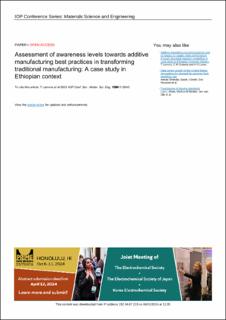| dc.contributor.author | Lemma, Tekalign | |
| dc.contributor.author | Lemu, Hirpa G. | |
| dc.contributor.author | Gutema, Endalkachew Mosisa | |
| dc.date.accessioned | 2024-03-14T11:42:29Z | |
| dc.date.available | 2024-03-14T11:42:29Z | |
| dc.date.created | 2024-01-03T07:55:21Z | |
| dc.date.issued | 2023 | |
| dc.identifier.citation | Lemma, T., Lemu, H. G., & Gutema, E. M. (2023, December). Assessment of awareness levels towards additive manufacturing best practices in transforming traditional manufacturing: A case study in Ethiopian context. In IOP Conference Series: Materials Science and Engineering (Vol. 1294, No. 1, p. 012045). IOP Publishing. | en_US |
| dc.identifier.issn | 1757-8981 | |
| dc.identifier.uri | https://hdl.handle.net/11250/3122406 | |
| dc.description.abstract | The main objective of this study is to assess the awarness levels of acadamic staffs and industry experts towards the best practices of additive manufacturing (AM) in transforming traditional manufacturing (TM) in local context. The study used closed ended questionnaires with 1-5 liker scales to collect secondary data from the respondents. The collected data were analyzed using descriptive statistics (frequency and percentage) by using SPSS v20 software. The findings of this paper identified ten (10) AM best practice benefit factors (Resource consumption benefit factor, Waste management benefit factor, Pollution control benefit factor Material utilization benefit factors, Design optimization benefit factor, Manufacturing flexibility best practice factors, SC flexibility benefit factors, SC network improvement benefit factor, Cost reduction benefit factors, Ability of changing customer demand benefit factors) in transforming traditional manufacturing in local context. Among the eight AM best practices both academic staffs and industry experts have common awareness level on five factors. In addition, the findings of the study showed that 49% of academic staffs and 37% of industry experts have good awarness levels towards the identified AM best practices in transfornig traditional manufacturing. Based on the findings of this study conceptual framework was developed for future research work to quantitatively investigate the effects of AM best practices on traditional manufacturing performmance. | en_US |
| dc.language.iso | eng | en_US |
| dc.publisher | IOP Publishing | en_US |
| dc.rights | Navngivelse 4.0 Internasjonal | * |
| dc.rights.uri | http://creativecommons.org/licenses/by/4.0/deed.no | * |
| dc.title | Assessment of awareness levels towards additive manufacturing best practices in transforming traditional manufacturing: A case study in Ethiopian context | en_US |
| dc.type | Peer reviewed | en_US |
| dc.type | Journal article | en_US |
| dc.description.version | publishedVersion | en_US |
| dc.rights.holder | The authors | en_US |
| dc.subject.nsi | VDP::Teknologi: 500 | en_US |
| dc.source.volume | 1294 | en_US |
| dc.source.journal | IOP Conference Series: Materials Science and Engineering | en_US |
| dc.identifier.doi | 10.1088/1757-899X/1294/1/012045 | |
| dc.identifier.cristin | 2219476 | |
| cristin.ispublished | true | |
| cristin.fulltext | original | |
| cristin.qualitycode | 1 | |

